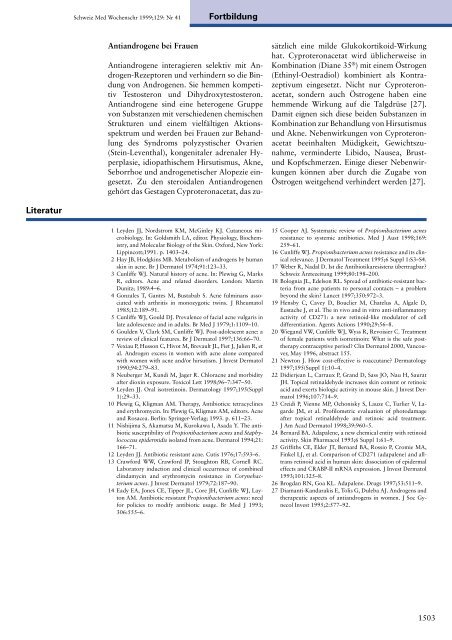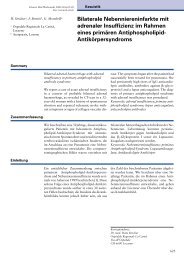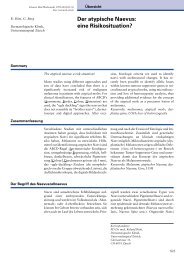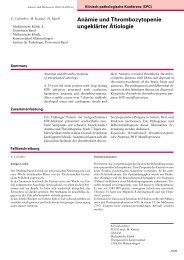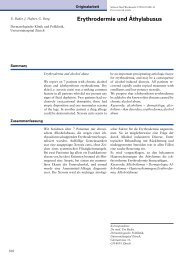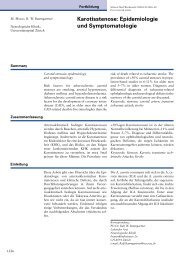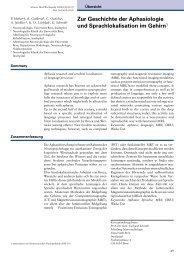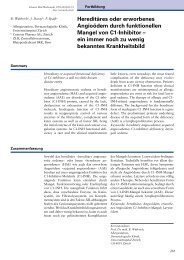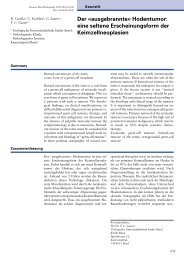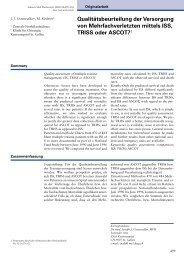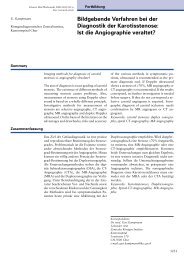Acne and its treatment
Acne and its treatment
Acne and its treatment
Erfolgreiche ePaper selbst erstellen
Machen Sie aus Ihren PDF Publikationen ein blätterbares Flipbook mit unserer einzigartigen Google optimierten e-Paper Software.
Schweiz Med Wochenschr 1999;129: Nr 41<br />
Fortbildung<br />
Anti<strong>and</strong>rogene bei Frauen<br />
Anti<strong>and</strong>rogene interagieren selektiv mit Androgen-Rezeptoren<br />
und verhindern so die Bindung<br />
von Androgenen. Sie hemmen kompetitiv<br />
Testosteron und Dihydroxytestosteron.<br />
Anti<strong>and</strong>rogene sind eine heterogene Gruppe<br />
von Substanzen mit verschiedenen chemischen<br />
Strukturen und einem vielfältigen Aktionsspektrum<br />
und werden bei Frauen zur Beh<strong>and</strong>lung<br />
des Syndroms polyzystischer Ovarien<br />
(Stein-Leventhal), kongenitaler adrenaler Hyperplasie,<br />
idiopathischem Hirsutismus, Akne,<br />
Seborrhoe und <strong>and</strong>rogenetischer Alopezie eingesetzt.<br />
Zu den steroidalen Anti<strong>and</strong>rogenen<br />
gehört das Gestagen Cyproteronacetat, das zusätzlich<br />
eine milde Glukokortikoid-Wirkung<br />
hat. Cyproteronacetat wird üblicherweise in<br />
Kombination (Diane 35 ® ) mit einem Östrogen<br />
(Ethinyl-Oestradiol) kombiniert als Kontrazeptivum<br />
eingesetzt. Nicht nur Cyproteronacetat,<br />
sondern auch Östrogene haben eine<br />
hemmende Wirkung auf die Talgdrüse [27].<br />
Damit eignen sich diese beiden Substanzen in<br />
Kombination zur Beh<strong>and</strong>lung von Hirsutismus<br />
und Akne. Nebenwirkungen von Cyproteronacetat<br />
beeinhalten Müdigkeit, Gewichtszunahme,<br />
verminderte Libido, Nausea, Brustund<br />
Kopfschmerzen. Einige dieser Nebenwirkungen<br />
können aber durch die Zugabe von<br />
Östrogen weitgehend verhindert werden [27].<br />
Literatur<br />
1 Leyden JJ, Nordstrom KM, McGinley KJ. Cutaneous microbiology.<br />
In: Goldsmith LA, editor. Physiology, Biochemistry,<br />
<strong>and</strong> Molecular Biology of the Skin. Oxford, New York:<br />
Lippincott;1991. p. 1403–24.<br />
2 Hay JB, Hodgkins MB. Metabolism of <strong>and</strong>rogens by human<br />
skin in acne. Br J Dermatol 1974;91:123–33.<br />
3 Cunliffe WJ. Natural history of acne. In: Plewisg G, Marks<br />
R, editors. <strong>Acne</strong> <strong>and</strong> related disorders. London: Martin<br />
Dunitz; 1989:4–6.<br />
4 Gonzales T, Gantes M, Bustabab S. <strong>Acne</strong> fulminans associated<br />
with arthritis in monozygotic twins. J Rheumatol<br />
1985;12:189–91.<br />
5 Cunliffe WJ, Gould DJ. Prevalence of facial acne vulgaris in<br />
late adolescence <strong>and</strong> in adults. Br Med J 1979;1:1109–10.<br />
6 Goulden V, Clark SM, Cunliffe WJ. Post-adolescent acne: a<br />
review of clinical features. Br J Dermatol 1997;136:66–70.<br />
7 Vexiau P, Husson C, Hivot M, Brevault JL, Fiet J, Julien R, et<br />
al. Androgen excess in women with acne alone compared<br />
with women with acne <strong>and</strong>/or hirsutism. J Invest Dermatol<br />
1990;94:279–83.<br />
8 Neuberger M, Kundi M, Jager R. Chloracne <strong>and</strong> morbidity<br />
after dioxin exposure. Toxicol Lett 1998;96–7:347–50.<br />
9 Leyden JJ. Oral isotretinoin. Dermatology 1997;195(Suppl<br />
1):29–33.<br />
10 Plewig G, Kligman AM. Therapy, Antibiotics: tetracyclines<br />
<strong>and</strong> erythromycin. In: Plewig G, Kligman AM, editors. <strong>Acne</strong><br />
<strong>and</strong> Rosacea. Berlin: Springer-Verlag; 1993. p. 611–23.<br />
11 Nishijima S, Akamatsu M, Kurokawa I, Asada Y. The antibiotic<br />
susceptibility of Propionibacterium acnes <strong>and</strong> Staphylococcus<br />
epidermidis isolated from acne. Dermatol 1994;21:<br />
166–71.<br />
12 Leyden JJ. Antibiotic resistant acne. Cutis 1976;17:593–6.<br />
13 Crawford WW, Crawford IP, Stoughton RB, Cornell RC.<br />
Laboratory induction <strong>and</strong> clinical occurrence of combined<br />
clindamycin <strong>and</strong> erythromycin resistance in Corynebacterium<br />
acnes. J Invest Dermatol 1979;72:187–90.<br />
14 Eady EA, Jones CE, Tipper JL, Core JH, Cunliffe WJ, Layton<br />
AM. Antibiotic resistant Propionibacterium acnes: need<br />
for policies to modify antibiotic usage. Br Med J 1993;<br />
306:555–6.<br />
15 Cooper AJ. Systematic review of Propionibacterium acnes<br />
resistance to systemic antibiotics. Med J Aust 1998;169:<br />
259–61.<br />
16 Cunliffe WJ. Propionibacterium acnes resistance <strong>and</strong> <strong>its</strong> clinical<br />
relevance. J Dermatol Treatment 1995;6 Suppl 1:S3–S4.<br />
17 Weber R, Nadal D. Ist die Antibiotikaresistenz übertragbar?<br />
Schweiz Ärztezeitung 1999;80:198–200.<br />
18 Bolognia JL, Edelson RL. Spread of antibiotic-resistant bacteria<br />
from acne patients to personal contacts – a problem<br />
beyond the skin? Lancet 1997;350:972–3.<br />
19 Hensby C, Cavey D, Bouclier M, Chatelus A, Algale D,<br />
Eustache J, et al. The in vivo <strong>and</strong> in vitro anti-inflammatory<br />
activity of CD271: a new retinoid-like modulator of cell<br />
differentiation. Agents Actions 1990;29:56–8.<br />
20 Wieg<strong>and</strong> VW, Cunliffe WJ, Wyss R, Revoisier C. Treatment<br />
of female patients with isotretinoin: What is the safe posttherapy<br />
contraceptive period? Clin Dermatol 2000, Vancouver,<br />
May 1996, abstract 155.<br />
21 Newton J. How cost-effective is roaccutane? Dermatology<br />
1997;195(Suppl 1):10–4.<br />
22 Didierjean L, Carraux P, Gr<strong>and</strong> D, Sass JO, Nau H, Saurat<br />
JH. Topical retinaldehyde increases skin content or retinoic<br />
acid <strong>and</strong> exerts biologic activity in mouse skin. J Invest Dermatol<br />
1996;107:714–9.<br />
23 Creidi P, Vienne MP, Ochonisky S, Lauze C, Turlier V, Lagarde<br />
JM, et al. Profilometric evaluation of photodamage<br />
after topical retinaldehyde <strong>and</strong> retinoic acid <strong>treatment</strong>.<br />
J Am Acad Dermatol 1998;39:960–5.<br />
24 Bernard BA. Adapalene, a new chemical entity with retinoid<br />
activity. Skin Pharmacol 1993;6 Suppl 1:61–9.<br />
25 Griffiths CE, Elder JT, Bernard BA, Rossio P, Cromie MA,<br />
Finkel LJ, et al. Comparison of CD271 (adapalene) <strong>and</strong> alltrans<br />
retinoid acid in human skin: dissociation of epidermal<br />
effects <strong>and</strong> CRABP-II mRNA expression. J Invest Dermatol<br />
1993;101:325–8.<br />
26 Brogdan RN, Goa KL. Adapalene. Drugs 1997;53:511–9.<br />
27 Diamanti-K<strong>and</strong>arakis E, Tolis G, Duleba AJ. Androgens <strong>and</strong><br />
therapeutic aspects of anti<strong>and</strong>rogens in women. J Soc Gynecol<br />
Invest 1995;2:577–92.<br />
1503


